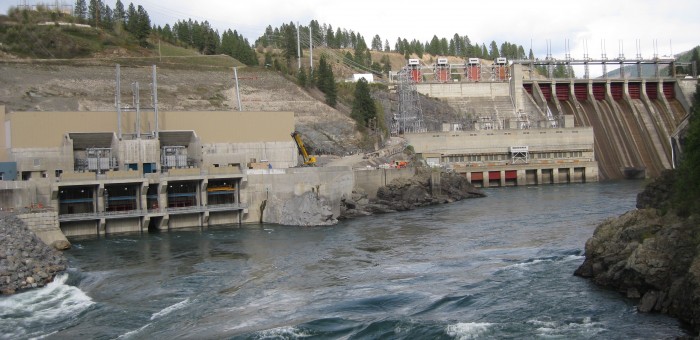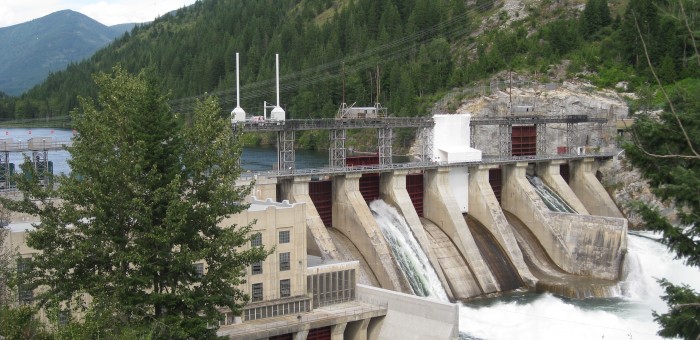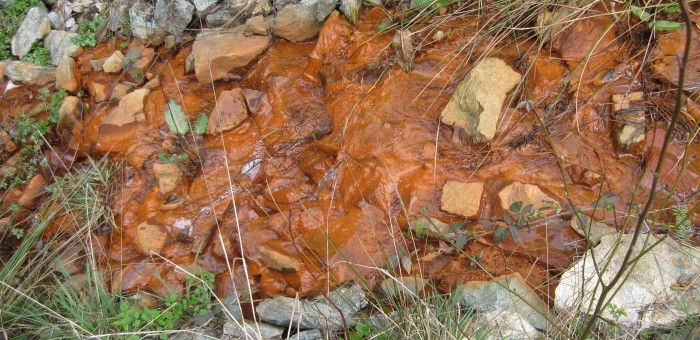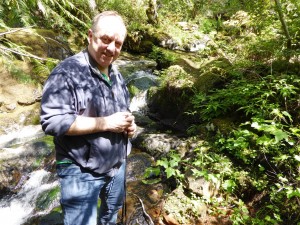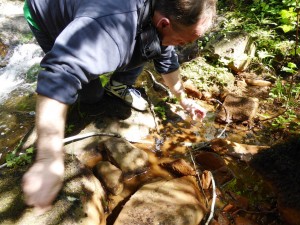Environment
Floods, Power and Fish: A Damming History
September 16, 2014 marked the 50th anniversary of the ratification of the Columbia River Treaty. It also triggered the beginning of a ten-year period for renegotiation for which we are now in the middle of the second year. As negotiations continue to evolve, I will provide ongoing analysis of the treaty process. In this, our first post on the topic, I offer a historical review of how we got to where we are today.
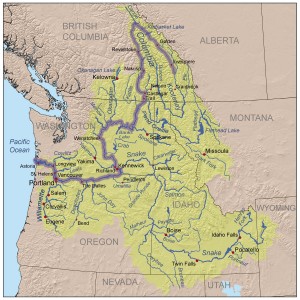 The ~2,000 km long Columbia River begins in British Columbia’s Rocky Mountains and stretches through Washington before reaching the Pacific Ocean northwest of Portland, Oregon. Its drainage basin (including the rivers that flow into and join with it) includes parts of British Columbia, Washington, Idaho, Oregon, Montana, Wyoming, Utah and Nevada. That’s an area of about 670,000 square kilometres which is greater than the size of Alberta.
The ~2,000 km long Columbia River begins in British Columbia’s Rocky Mountains and stretches through Washington before reaching the Pacific Ocean northwest of Portland, Oregon. Its drainage basin (including the rivers that flow into and join with it) includes parts of British Columbia, Washington, Idaho, Oregon, Montana, Wyoming, Utah and Nevada. That’s an area of about 670,000 square kilometres which is greater than the size of Alberta.
The Columbia River has played a pivotal role in the economic development of British Columbia and it all began in the 1930s. During that time, the United States realized that it could harness the Columbia by damming it; it could then use the river for power generation, flood control, channel navigation and irrigation. The United States quickly realized, however, that to truly maximize the potential of the river — and to truly be able to control the possibility of severe flooding — it would also need to harness the river on the Canadian side. This need to enter into transboundary cooperation was underscored when a 1948 flood caused extensive damage from Trail, British Columbia to Astoria, Oregon, completely destroying Vanport, Oregon’s second largest city in a day. Sixteen years later, in 1964, the Columbia River Treaty was formally ratified, allowing for the development and operation of dams in British Columbia and thereby creating power and providing flood control for both Canada and the United States.
After the treaty was signed, British Columbia built three dams that have been continuously used to provide flood management and electrical generation (through hydropower) both in British Columbia and the United States. In return for the construction and extended reciprocal use of these dams, British Columbia receives, from the United States, an annual Canadian Entitlement now valued at between $250 and $350 million. As a result, electricity generated downstream, in the United States, provides nearly half of the city of Los Angeles’ electricity, while water from the dam system irrigates more than 7.3 million acres of previously non-arable land. In addition to the benefits provided to the United States and our own Canadian Entitlement, the Columbia River Basin now provides approximately half of the power generation capacity of British Columbia. So even without knowing it, each and every one of us continues to be affected daily by the 1964 Columbia River Treaty every time we turn on the lights or our televisions.
 It’s pretty clear how British Columbia benefits from the treaty: we get flood control, we get electricity, and we get an annual payment from the United States. For all of its benefits, however, it’s important to consider how the treaty impacts our province. Treaty dams flood almost 600 square kilometres of bottomland in British Columbia and the flooding affected residents of areas that were either flooded or were near the flooding. Furthermore, much of the land impacted is of cultural and titular importance to local First Nations.
It’s pretty clear how British Columbia benefits from the treaty: we get flood control, we get electricity, and we get an annual payment from the United States. For all of its benefits, however, it’s important to consider how the treaty impacts our province. Treaty dams flood almost 600 square kilometres of bottomland in British Columbia and the flooding affected residents of areas that were either flooded or were near the flooding. Furthermore, much of the land impacted is of cultural and titular importance to local First Nations.
In an effort to implement the treaty in a short amount of time, the British Columbia government did not substantively consider the impacts of altering the natural flow of the river. The result of this lack of consideration has meant that the people of the Columbia River basin have neither had much say in the development of the river, nor have they seen substantial direct economic benefits to their communities. This lack of consideration also extended to environmental issues, which, in the 1950s and 60s, were not of paramount importance during the negotiations. The use of British Columbia land, through the treaty, does not identify ecosystem considerations; it does not account for the potential implications of climate change; nor does it include mechanisms that allow for adaptation according to changing environmental, economic and regional conditions. Agriculture — in and around the Columbia River — has been required to change. Local ecosystems have shifted. Fish populations that previously used the river have disappeared or altered their activities. Although we have not “destroyed” the Columbia River basin, we have certainly had an impact on it.
In 1995 the Columbia Basin Trust was set up as after residents, including local government officials and First Nations, of the Columbia Basin approached the British Columbia Government with a request (as taken from the Columbia Basin Trust website):
- funds be allocated to the region, representing a fair share of the ongoing benefits being realized outside of the Basin as a result of the Columbia Basin Trust;
- a regional organization, governed by a board of Basin residents, be created to manage those funds.
As noted above, we are currently in the middle of the second year of a ten-year period of renegotiation. Both the United States and Canada have set up review committees to examine the current treaty and its effects. Both committees have advised that each country would substantially benefit from the continuation of the treaty. The issue becomes more complicated when the committees consider the costs and benefits for each jurisdiction. For example, the United States asserts that Canada is currently receiving more than its fair share of entitlements, while British Columbia believes that intangible benefits to the United States from our own water management are not currently accounted for under the treaty. Moreover, while both parties agree that accommodating environmental factors is a high priority, recommendations on the process for their accommodation vary. One thing that is certain, the negotiation process will ultimately play an important role in deciding the energy future of British Columbia.
Ultimately, the Columbia River Treaty renegotiation offers the potential for British Columbia to continue to play a major role in the energy sector of the Pacific Southwest. Furthermore, it gives British Columbia the opportunity to position itself as a leader in sustainable energy production and transnational energy cooperation.
If you are interested in further information, please consider reading the details of the regional recommendations from the United States and the recommendations from British Columbia. The province of British Columbia also provides information concerning negotiations on an ongoing basis.
As LNG bill passes, BC at odds with global community on climate change
Media Statement July 21st 2015
As LNG bill passes, British Columbia is at odds with the global community on climate change
For Immediate Release
Victoria B.C. – British Columbia is at odds with the global community, who are calling for governments to take immediate action on addressing and mitigating climate change according to Andrew Weaver, MLA for Oak Bay-Gordon Head and Deputy Leader of the B.C. Green Party. This statement comes a week after calling for an emergency debate on whether B.C. legislators are acting with sufficient urgency or demonstrating the leadership needed to mitigate and prepare for climate change.
Yesterday, twenty four of the UK’s foremost academic and professional institutions – including the British Academy, the Royal Society, and the Learned Society of Wales – released a statement that said “responding to the challenge [of climate change] will require deploying the full breadth of human talent and invention. Creative policy interventions and novel technological solutions need to be fostered and applied… Capturing this potential quickly and effectively will drive economic progress.”
“Today the B.C. Liberals are forcing through legislation that they desperately hope will land a single LNG investment,” said Weaver. “At a time when it is imperative that we are making meaningful investments in low-carbon technologies, the B.C. Liberals are pulling out the stops to build fossil fuel infrastructure that will commit the province to an energy-intensive non-renewable industry for the foreseeable future.”
In reference to the regional droughts, forest fires, lack of snowpack, and fishery closures currently affecting B.C., Andrew Weaver last week urged the House suspend discussion of LNG legislation to discuss the government’s inaction on climate change. Responding to MLA Weaver’s statement, Finance Minister Michael de Jong said, “…we have certainly experienced some extreme conditions in the province these past number of weeks that have contributed to some challenging circumstances. We heard about that earlier from the minister. Nor do I doubt the member’s interest and commitment to addressing some of the underlying issues that may or may not be contributing to that. Having said that, we are also bound and obliged to conduct proceedings in this chamber pursuant to the standing orders.”
Both the BC NDP and the BC Liberals argued against having an emergency one hour debate on climate change.
“The juxtaposition of the B.C. government being called into a summer session to push LNG legislation through, unwilling to spend an hour discussing our response to climate change while salmon are dying in warm rivers before they can spawn, Gulf Islands are starting to truck in fresh water, and the Premier’s own riding is on fire is incredibly striking, and only further highlights the inaction we are seeing” said Weaver.
“British Columbia has all the tools it needs to tackle climate change head on; we have the renewable resources required, and the innovative, creative, and inspired population,” said Andrew Weaver. “The missing element is a government willing to demonstrate the leadership required to focus the efforts. Right now they seem content to continue rearranging deck chairs on the Titanic.”
-30-
Media contact
Mat Wright
Press Secretary – Andrew Weaver MLA
Cell: 250 216 3382
Mat.wright@leg.bc.ca
Twitter: @MatVic
Parliament Buildings
Room 027C
Victoria BC V8V 1X4
Bill M229 — Energy and Water Efficiency Act, 2015
Today in the legislature I rose to table Private Members’ Bill entitled: Bill M229 — Energy and Water Efficiency Act, 2015. As I noted in introducing it, this Bill was originally tabled by the Liberal government in 2012 as Bill 32 — Energy and Water Efficiency Act. The Bill received support from all sides of the legislature when it was introduced in 2012. Unfortunately, it was never brought to the Committee of the whole house and subsequently third reading. We missed an opportunity in 2012 to pass this legislation. I hope that the government chooses to pick this up at this time.
Text of the Introduction of my Bill
I’m pleased to introduce a bill intituled the Energy and Water Efficiency Act. If this title sounds familiar, it’s because the act was initially introduced in 2012 and passed second reading with the support of the official opposition on April 24, 2012, but the Committee of the Whole House was never called during the fourth session of the 39th Parliament and so the bill died on the order paper.
This bill reflects the new language in the Greenhouse Gas Industrial Reporting and Control Act. As noted by the Minister of Energy and Mines at the time, this bill would reduce consumers’ energy bills and lower operating costs for B.C. businesses. This legislation replaces the current Energy Efficiency Act and would enable administrative penalties to ensure manufacturers, distributors and retailers comply with energy efficiency guidelines, broaden the scope of energy efficiency requirements to include commercial energy systems, industrial reporting on water efficiency and enable the minister responsible to enact regulations for technical standards.
It was a fine, widely supported piece of legislation that was introduced after engaging more than 40 organizations and 60 individuals representing industry, utilities, governments, public interest and academia.
I move the bill be placed on the orders of the day for second reading at the next sitting of the House after today.
Video of the Introduction of my Bill
Soils in the Shawnigan Lake Watershed — More Questions
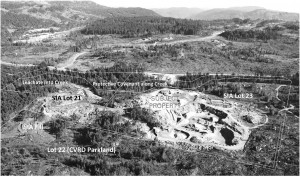 Back in April I wrote a piece on the wisdom of dumping contaminated soils in the Shawnigan Lake watershed. I visited the region with Shawnigan Lake Area Director Sonia Furstenau. Together with a few other Shawnigan Lake residents, we hiked around on parkland owned by the Cowichan Valley Regional District. I took this opportunity to take a number of photographs. More importantly, I took the opportunity to collect water samples.
Back in April I wrote a piece on the wisdom of dumping contaminated soils in the Shawnigan Lake watershed. I visited the region with Shawnigan Lake Area Director Sonia Furstenau. Together with a few other Shawnigan Lake residents, we hiked around on parkland owned by the Cowichan Valley Regional District. I took this opportunity to take a number of photographs. More importantly, I took the opportunity to collect water samples.
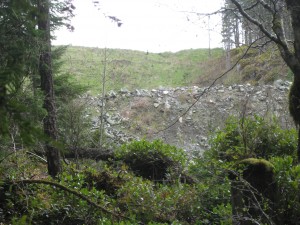 The results of these water samples, together with my observation that a significant amount of fill had over run Lot 21 and was on the neighbouring parkland, led me to subsequently ask the Minister of Energy and Mines and the Minister of Environment questions in Question Period.
The results of these water samples, together with my observation that a significant amount of fill had over run Lot 21 and was on the neighbouring parkland, led me to subsequently ask the Minister of Energy and Mines and the Minister of Environment questions in Question Period.
As background, Lot 21 is the property located at 638 Stebbings Road and is owned by 0782484 B.C. Ltd. For several years, soil has been dumped Lot 21 for later use to backfill the quarry in lot 23. A photograph of the northern boundary wall of deposited soils is shown to the left. This photograph was taken from CVRD Parkland on the north side of Shawnigan Creek.
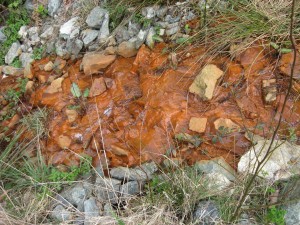 I outlined in my earlier post that it was apparent to me that substantial amounts of building materials had been placed on Lot 21. There was also clear evidence that runoff from this site failed drinking water standards at the point of entry with Shawnigan Creek. And visually, this water looked nothing like any other water in nearby surface and running water (see image to the right).
I outlined in my earlier post that it was apparent to me that substantial amounts of building materials had been placed on Lot 21. There was also clear evidence that runoff from this site failed drinking water standards at the point of entry with Shawnigan Creek. And visually, this water looked nothing like any other water in nearby surface and running water (see image to the right).
On May 15th I went back to the area to get a better sense as to what metals were contained in the orange sediments under the orange water. Since the water runoff came from Lot 21, my goal was to determine if sediments in this stream were any different from sediments at a control location upstream of Lot 21.
Four different sediment samples were obtained. Two of the samples were collected upstream of Lot 21 in order to obtain a control sample. The first, termed FLOW, in the attached data, was taken in the middle of Shawnigan Creek (see Figure 1 below). FLOW data will be used as the control sample below. The second sample (BANK in the attached data) was located at the bank of Shawnigan Creek immediately adjacent to where FLOW was collected.
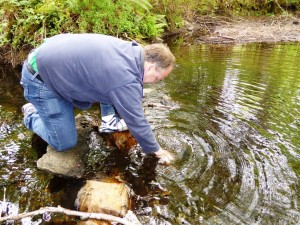
Figure 1: Photographs showing me collecting the control sediment sample in the middle of Shawnigan Creek, upstream from Lot 21.
The third and fourth samples were collected where the orange runoff entered Shawnigan Creek (Figure 2), The third, termed CREEK, in the attached data, was taken in Shawnigan Creek right at the location where the runoff enters the creek. The fourth sample was obtained about a metre upstream of the runoff stream. This is termed POOL in the attached data.
Figure 2: Photographs showing me collecting the sediment samples at the location where the Lot 21 runoff meets Shawnigan Creek (left) and in a pool a metre or so upstream of the creek in the covenant along Shawnigan Creek (right).
As in my earlier post, the metal contents in the sediments were determined using an inductively coupled plasma mass spectrometry (ICPMS). The method for the bulk analysis of acid extractable elements (that is trace elements not bound in silicate minerals) was as follows:
1) The vial was shaken to homogenize and all for the removal of an aliquot for analysis (2 mL aliquot for BANK and POOL, 10 mL aliquot for CREEK and FLOW).
2) 10 mL of 8 Molar Environmental Grade Nitric Acid was added and allowed to react overnight.
3) The sample was diluted to 50 mL with 18 mega ohm deionized water.
4) The mixture was shaken to homgenize
5) The sample was put in a centrifuge for fifteen 5 minutes at 3000 rpm to separate out any residual particulate.
All concentrations in the attached data are given in (μg/L). Since there were different amounts of sediments in the individual samples, it is not possible to directly compare their element concentrations. Rather, I will focus on what is called the enrichment factor for each element after normalization with the commonly occurring element Calcium (Ca).
By definition then, the enrichment factor of a mineral XX is:
Enrichment Factor = (XX[sample]/Ca[sample])/(XX[control]/Ca[control])
Here [sample] refers to the concentration in a collected sample (in μg/L) and [control] means the concentration in the control sample (also in μg/L).
The attached data clearly show the presence of an enriched industrial metal content of the POOL Sample.
The following elements were found to be enriched by:
Between three and four times the control values:
Magnesium (Mg), Vanadium (V), Chromium (Cr), Manganese (Mn), Cobalt (Co), Molybdenum(Mo), Caesium (Cs), Barium (Ba), Hafnium (Hf).
Between four and five times the control values:
Lithium (Li), Scandium (Sc), Germanium (Ge), Zirconium (Zr), Tin (Sn).
Between five and ten times the control values:
Niobium (Nb) [enriched 5.29 times higher than control]; Lead (Pb) [enriched 5.19 times higher than control].
Greater that ten times the control values:
Iron (Fe) [enriched 11.69 times higher than control]; Thorium (Th) [enriched 18.60 times higher than control].
After examining the elemental sediment analysis, I am left with a number of serious concerns. The enriched metal values in the sediments under the runoff leaving Lot 21 suggest that their source comes from somewhere upstream and likely within Lot 21 itself. The question I am left with is this:
What, if anything, has been buried on Lot 21 that could produce the Thorium, Lead and other heavy metal enrichment in the sediments?
Calling for Emergency Debate on BC’s response to Climate Change
Today in the Legislature I rose, pursuant to a seldom used provision in the Standing Orders, to call for an emergency debate on whether or not BC is acting with sufficient urgency and demonstrating the appropriate leadership on preparing for and mitigating the escalating impacts of climate change on our province. Below I provide the rationale for why I believed that holding such a debate was of urgent public importance. I further reproduce the media release that accompanied my speech, a backgrounder, and details concerning the Standing Order.
What is remarkable is that both the BC Liberal and BC NDP house leaders (Mike de Jong and Mike Farnworth) spoke against having such a debate. The Speaker eventually ruled against proceeding with the debate shortly before the house adjourned. It wasn’t a surprise that the Speaker ruled this way in light of the fact that both house leaders spoke against spending a mere one hour debating British Columbia’s climate policy. If fact she specifically cited their comments as being helpful in informing her as she wrote her decision.
My Justification
Madame Speaker, I rise pursuant to Standing Order 35. As advised in Standing Order 35, I gave the chair advance notice and I have provided a written statement of the matter proposed to the clerk.
By leave, I move that this House do now adjourn to discuss a matter of urgent public importance.
Namely, that in light of this year’s record temperatures, drought, lack of snow pack, and forest fires, and with a 90% probability that El Niño will persist into the winter exacerbating present conditions, whether we as legislators are acting with sufficient urgency and demonstrating the appropriate leadership on preparing for and mitigating the escalating impacts of climate change on our province.
To be clear, I am not calling for a debate on the impacts of climate change. Standing Order 35 excludes debating a matter of an ongoing nature, and there is no doubt that climate change will challenge every aspect of life in our province for decades to come.
However, as laid out in my motion, the matter of urgent public importance concerns whether we as legislators are acting with sufficient urgency and demonstrating the appropriate leadership on preparing for and mitigating the escalating impacts of climate change on our province.
I submit to you, Madame Speaker, and to the House that this session offers us no other adequate opportunity to have this debate, a debate that is urgent and in the public interest given the upcoming United Nations Framework Convention on Climate Change discussions that will be taking place at the 21st Conference of Parties in Paris this December, a conference where our Premier will be speaking about B.C’s supposed climate leadership.
This debate is particularly urgent as the government plans to use carbon offsets through the protection of forests to help reach our legislated greenhouse gas reduction targets. Yet under UNFCCC rules, government cannot adopt this risky path unless it also includes emissions from forest fires in annual reporting.
As legislators, it is critical that we have the opportunity to have this debate prior to any representations being made on a global stage regarding BC’s planned response to climate change.
There will be no other opportunity to have this debate during the session. And with uncertainty as to whether we will have another legislative sitting in advance of this conference, it is critically important that this chamber turn its attention to our role as legislators in addressing climate change, providing the people of British Columbia an opportunity to hear where its government stands on whether it is acting appropriately and urgently in the face of the extreme weather-related events happening around us.
There are few debates that are more urgent or are of greater public importance.
Response from BC Liberal House Leader – Mike de Jong
Thanks to the member. I’m relatively certain of two things. One is we have certainly experienced some extreme conditions in the province these past number of weeks that have contributed to some challenging circumstances. We heard about that earlier from the minister. Nor do I doubt the member’s interest and commitment to addressing some of the underlying issues that may or may not be contributing to that.
Having said that, we are also bound and obliged to conduct proceedings in this chamber pursuant to the standing orders. The member has risen pursuant to Standing Order 35. It is very much the urgency of debate that the Chair in past rulings focussing on these matters addressed. Though I can appreciate that the member would prefer the dedicated time that Standing Order 35 would provide for addressing this matter, there are other opportunities during the time that the House is sitting to raise these matters and have them considered by members.
In my respectful submission to the House and to the member, the motion…. I listened carefully to the motion. I haven’t seen it yet, but I listened as the member read it into the record. I would suggest the motion falls short of the historic threshold for adopting and moving to a Standing Order 35 debate, but as always, I will anxiously await the Chair’s ruling on the matter.
Response from BC NDP House Leader – Mike Farnworth
I, too, have listened to the hon. member’s motion. There is much in the motion that I believe has merit.
I would also, I think, point out that at this particular time, given what the member has said about the Premier going to this conference in December, that a fall session, which we are all expecting, would be an appropriate time, with advance notice, for all members to be able to participate in such a discussion around an important issue such as this. I think it would be something that members of the House would want to do.
So I would suggest at this particular time that the Speaker might want to think about an appropriate time in a fall session for this very important debate to take place, before a Premier heads off to a major international conference. But of course, hon. Speaker, we will abide by your ruling.
Press Release
Media Release- July 13th 2015
Andrew Weaver Calls for Emergency Debate on BC’s response to Climate Change
For Immediate Release
Victoria B.C. – Today, Andrew Weaver, MLA for Oak Bay-Gordon Head and Deputy Leader of the B.C. Green Party, called for an emergency debate on how British Columbia is responding to climate change, arguing that the debate is “a matter of urgent public importance”.
“We are experiencing forest fires, fishing bans, water restrictions and air quality advisories all occurring at alarming rates. In the backdrop of everything that is going on right now, there are few issues more urgent or of greater public importance than the actions we need to take immediately to tackle climate change,” said Andrew Weaver.
To be debated, matters of urgent public importance must be approved by the Speaker and granted leave by the House.
Both the BC NDP and the BC Liberals spoke against having an emergency debate on climate change. The Legislature is waiting for the speaker to rule on whether the motion will be heard.
While 2015 may go down as an extreme year, these conditions will become more and more common and more and more extreme for the province as global warming worsens.
“It is sadly ironic that as our forests burn, snowpack melts, and frequency of severe summer droughts increase, the government is forcing through its generational sellout embodied in the 25-year LNG agreement with Petronas,” said Andrew Weaver. “The impacts and costs of climate change have never been clearer for British Columbians. It’s time we consider what kind of future we want.”
-30-
Mat Wright
Press Secretary – Andrew Weaver, MLA
Cell: 250 216 3382
Email: Mat.Wright@leg.bc.ca
Backgrounder – Summer 2015 Extreme Weather Events
While climate scientists are careful to point out that individual weather events cannot be directly connected to global warming, changes in the frequency and intensity of such events can be detected and attributable to human-caused global warming.
Wildfires
• Between April 1st and July 12th, 2015 there have been 1,069 wildfires in British Columbia, with 221 fires currently active across the province.
• Over $108 million has been spent so far this year fighting forest fires.
Water
• Two areas of Vancouver Island, Parksville and The Regional District of Nanaimo, have introduced Level 4 water bans, the highest water restriction possible.
• Metro Vancouver’s reservoirs are being depleted at a far faster than normal rate in “an unprecedented dry year”.
• On June 15, Province-wide snowpack levels were only at five per cent of normal conditions for that time of the year. Other basins, including the Lower Fraser, Okanagan, South Coast and Vancouver Island saw their snowpack surveyed at zero percent of normal levels.
Fish
•Salmon thrive in water temperatures between 13 and 18 degrees Celsius, once water temperatures hit 19 degrees the fish begin to show physiological signs of stress and they slow their upstream migration. At 20 degrees, there are disease outbreaks and fish start to die.
•The Fraser River is currently around 19 degrees.
Rivers are so low and warm this summer that the province has suspended sport fishing in streams and rivers for southern Vancouver Island and the Gulf Islands.
Air Quality
• Health authorities say that Metro Vancouver’s air quality dipped close to levels found in major Chinese cities, such as Beijing, because of the forest fire smoke.
July 6th, 2015:
Beijing: 144 μg/m3
Burnaby North: 112 μg/m3
Temperature
• The weekend of June 27th, 2015 saw 64 temperature records broken across British Columbia.
Standing Order 35
Below are the details of Standing Order 35 which was last used in 2008.
Adjournment on Matter of Urgent
Public Importance
Adjournment for special purposes.
35. (1) Leave to make a motion for the adjournment of the House, when made for the purpose of discussing a definite matter of urgent public importance, must be asked after the ordinary daily routine of business (Standing Order 25) has been concluded and before Orders of the Day are entered on.
Making statement.
(2) A Member wishing to move, “That this House do now adjourn” under this Standing Order, shall rise and state the matter briefly.
Written statement to Speaker.
(3) After the Member has stated the matter, he or she shall hand a written statement of the matter proposed to be discussed to the Speaker.
Decision.
(4) If the Speaker decides that the statement is in order and is of urgent public importance, he or she shall read the statement aloud and ask whether the Member has leave to move the motion. If objection is taken, the question of leave shall be decided on division without debate.
Speaker may defer decision.
(5) The Speaker may defer the decision upon whether or not the statement is in order and of urgent public importance. The proceedings of the House may be interrupted later for the purpose of announcing the decision.
Debate may be deferred.
(6) If leave has been obtained, the motion may stand over until 4.30 p.m. on that day, or the Speaker may direct that the motion be set down for consideration on the following sitting day at an hour specified by him or her.
[ (7) not in use as per Consequential Amendment – Motion passed February 10, 2004 ]
Motion on Friday.
(7) If leave has been obtained on any Friday, the motion shall stand over until 4.30 p.m. the next sitting day, unless the Speaker shall direct that the motion be set down for consideration later the same Friday.
Time limits.
(8) The debate on the motion shall not exceed one hour, apportioned as follows:
Mover: 15 minutes
Other Members: 10 minutes each
Debate concluded.
(9) Upon expiration of the time limited for debate, the motion lapses and the House shall proceed to Orders of the Day or the next order of business, unless the House otherwise orders.
Restrictions.
(10) The right to move the adjournment of the House under this Standing Order is subject to the following restrictions:
(a) not more than one such motion may be made at the same sitting;
(b) not more than one matter shall be discussed on the same motion;
(c) the motion must not revive discussion on a matter which has been discussed in the same Session;
(d) the motion must not anticipate a matter which has been previously appointed for consideration by the House, or with respect to which a notice of motion has been previously given and not withdrawn;
(e) the motion must not raise a question of privilege;
(f) the discussion under the motion must not raise any question which, according to the Standing Orders of the House, can only be debated on a motion under notice.

